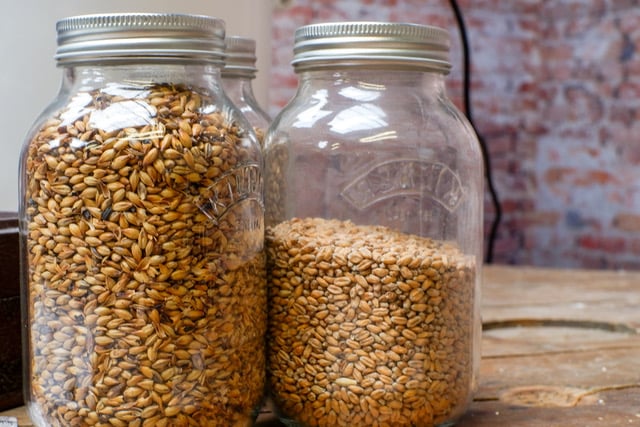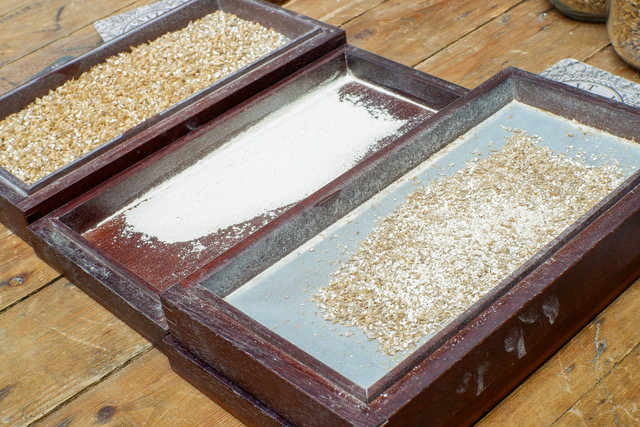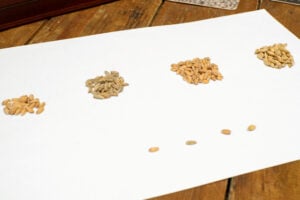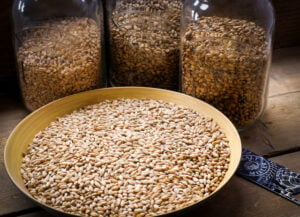Mill your own malt at home
With the launch of the Grainfather Electric Grain Mill, now’s a great time to try milling your own malt at home.
Whole (uncrushed) malts have a much longer shelf life than crushed malts – months rather than weeks. Once malt is crushed, the grains begin to dry out, affecting the flavours inside. This happens much more rapidly when the grain is exposed to the air, which is why we heat seal all our crushed malts immediately after crushing before sending them out to you. We recommend crushed malts are used as soon as possible to get the maximum flavour and are kept sealed in the bags we supply until you’re ready to use them.
If you have your own malt mill, you can buy whole malts and crush right before your brewday, giving you the freshest possible flavour. You can also benefit from the lower prices of 25kg sacks of malt knowing that the grains will stay fresh to the end. We are happy to supply full 25kg sacks crushed and ready to use, but for most uses we recommend the 5 x 5kg option to help with freshness and consistency throughout.
The Grainfather Electric Grain Mill – key features
Many mills aimed at homebrewers are manually driven or rely on attaching a power drill. The Grainfather mill is fully automatic electric drive, giving you a consistent speed of crush throughout your batch. The hopper takes 1kg of grain and can be topped up throughout crushing. The mill runs for six minutes before needing to cool down, which is enough to process enough for a standard size batch. If you need to crush more malt, give the mill a break for about three minutes before you carry on.
There’s a gated outlet from the hopper, which stops the rollers clogging and also limits the amount of dust coming back at you. Beneath that are the rollers: these are made from hardened steel and are knurled to help keep grain husks intact, giving you a better quality of crush. There’s a stepped roller gap adjustment (more on crush size below) and adjustable speed. We recommend using speed level 4 – we’ve tried it faster and it begins to pulverise the husks, which can cause problems in your mash.
It’s important to make sure your grain is kept dry as possible and isn’t pre-conditioned in any way. This mill is designed for use with dry grains only.
The mill comes with a bamboo mounting board that’s the right size to sit over a standard plastic fermenting bucket. If you want to mount the mill to the board, you just need to drill a couple of 4mm holes. You can also mount the mill to your own worktop or any other surface as you need. See our unboxing video for more info on fitting the included bamboo mounting board.
Mind the gap


Choosing the right mill gap is vital to getting an effective crush and, even more importantly, to a stress-free brewday! Milling too coarsely will affect your efficiency, meaning missed targets and unwanted flavours, while milling too fine could result in the nightmare of a stuck mash.
Malt needs to be crushed to allow your mash liquor to dissolve the sugars inside the husk. If the husks aren’t cracked fully open, the liquor won’t penetrate and some of those sugars will escape. While a finer crush level exposes more of those sugars, potentially improving mash efficiency, pulverising the grain into flour can turn your mash into gluey porridge. Grain husks act as a filter to prevent this happening, providing channels for the mash liquor to drain and preventing gumming. Fine crush levels are a good idea for BIAB or no-sparge brews with very thin mashes, but even then there are limits, and crushing into powder is never a good idea.
One size fits (almost) no-one

There is no single gap setting for milling malt for the simple reason that different malts have different size grains. Base malts like pilsner or Maris Otter have plumper kernels with a clear husk. The husks on roasted malts are brittle and break easily, while huskless malts like wheat malt or rye malt have much smaller kernels that could slip uncrushed between the rollers if not adjusted accordingly.
The Grainfather mill has an adjustable roller gap with settings from 1 (finest) to 10 (coarsest). For base malts in particular – the majority of your grist – we’re looking for the husk to be largely intact, with the inner kernel being easy to break up in your fingers.
Here at The Malt Miller we’ve been milling malt for homebrewers for over ten years. We continuously calibrate our industrial scale mills with a grist separation box to make our crush levels give the right fraction of coarse grain (husks and other material), fine grain (the sugars you need), and flour from each type of malt.
You can see how we test the grain in this video.
Our recommended settings
We’ve tested the Grainfather mill in the same way as our industrial mills to determine the correct settings. These are the settings we suggest for brewing with a traditional three-vessel setup and all-in-one brewing systems like the Grainfather G30 and G70. For BIAB, where a finer crush can improve efficiency, you can go one step finer.
- Base malts (pils, pale, etc.) = 6
- Wheat malt, rye malt, spelt malt = 4
- Oat malt = 3
- Caramel and crystal malts = 6
- Roasted and black malts = 6
These are all at speed level 4 – as noted before, too fast and the grains get completely pulverised!
Grainfather officially suggest finer settings for roasted and black malt etc. We personally don’t recommend this: the husks on highly roasted malts don’t crack like base malts and instead crumble without needing particularly fine crushing. You’ll still extract the same level of colour and flavour with a coarser crush, and if you make a porter or stout with a high proportion of roasted malts you won’t run the risk of a stuck mash.
The best malts for the home brewer

We’re proud of the range of malts we stock, and with the launch of the Grainfather mill we’re really excited that more and more home brewers can get the freshest and best-tasting crush for your beer.
For more product videos and home brewing tips, check out our YouTube channel or drop a comment on our Facebook page.

